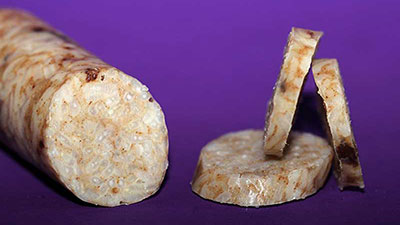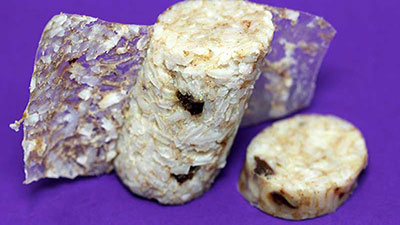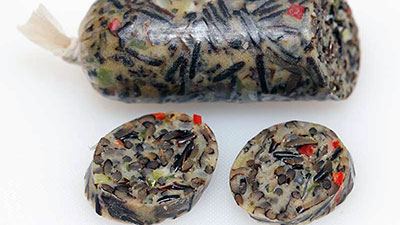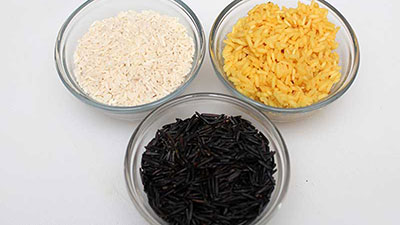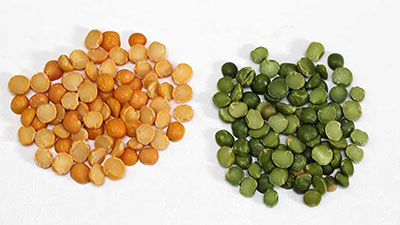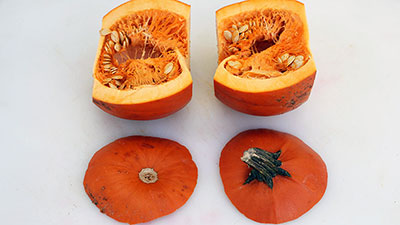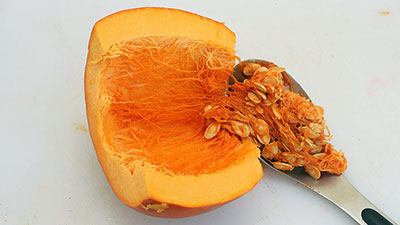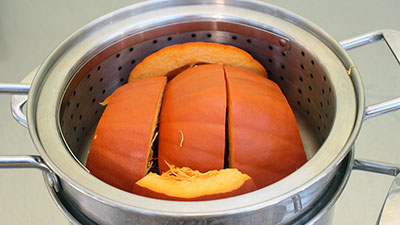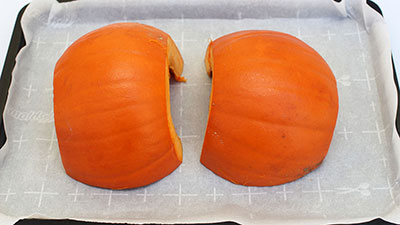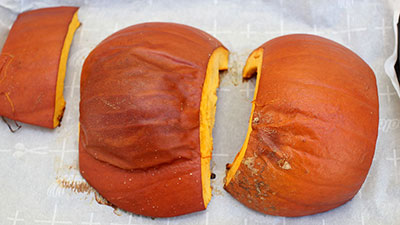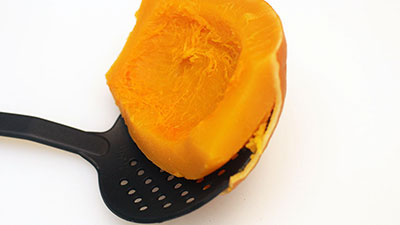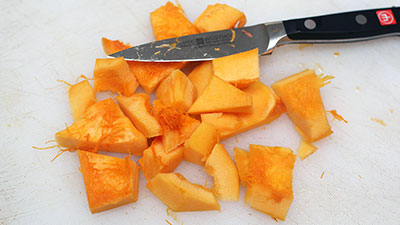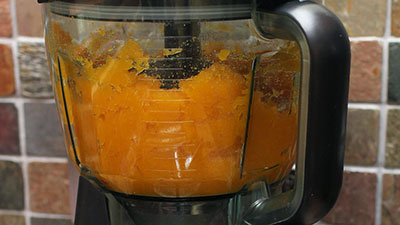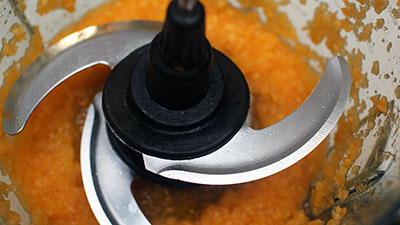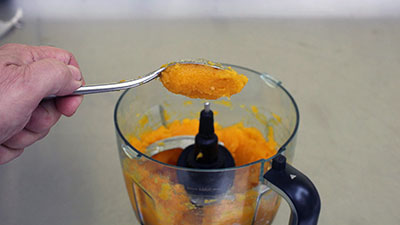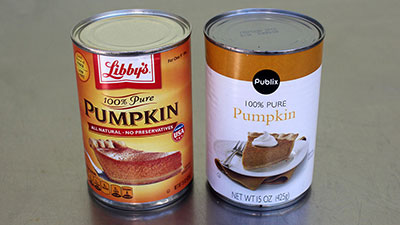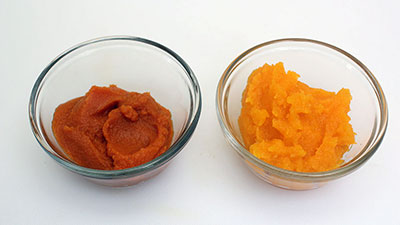Meats and Sausages
Vegetarian Sausages
Vegetarian sausages are much healthier as they don’t contain animal fat or cholesterol. The amount of salt, oil and calories can be adjusted using the same rules that apply for making other sausages. The hardest problem to solve is to duplicate the flavor of meat. The fact should be accepted that a sausage that is made without meat has a different flavor and cannot compete with a traditionally made meat product. However, it does have its individual character and it does not need to imitate or compete with meat sausages.
What is a Vegetarian Sausage?
Well, by traditional definition, a sausage was spiced meat stuffed into a casing. When the first sausages were made, we did not know how to grow crops or make products like tofu, so the sausages were made with meat. The necessity of survival established the quality; the product was good if it lasted longer than a few days. Does a bear worry about the flavor of the product he consumes? He worries about the amount of food he needs to store in order to survive the winter. As meat and especially fat rank on top of food products rich in calories, it is not surprising that eating berries, grains, or other non-animal products was not the priority. During the salmon run, the bear will devour only fillets, discarding the carcass of the fish. He would not have enough stored calories to survive the approaching winter if he had not gained sufficient weight.
A pound of fat supplies 4,077 calories which is enough to sustain body functions for 2 days. No other food comes close in caloric value, so it is not surprising that meat and fat were held in such high esteem. In time, as we started to cultivate grains, new products appeared, such as bread and porridge. The choice of a filler material was not dictated by its flavor but by its availability in a local area. The food shortages and famine, especially after the First and the Second World Wars, contributed to the development of sausages which broke the old tradition of using meat only. Now, in addition to meat, the sausages also contained fillers such as potatoes, dry rolls, bread crumbs, rice, flour, corn meal, and barley and buckwheat grains.
Vegetarian Sausages and other products go one step further; they don't use meat at all. This sounds exciting; however, some manufacturing problems must be dealt with:
- Flavor and Color
- Texture
- Binding Ingredients
- Fat Replacement
Flavor
The flavor of sausage is the sum of texture, the flavor of basic materials, spices, the amount of fat, and the amount of water. There is not one unique meat flavor; pork, beef, sheep, poultry, and fish have different colors and flavors. Even different meat cuts from the same animal exhibit different flavors: pork belly, loin, shoulder or liver, they all have different flavor. Meat coming from older animals has a more pronounced flavor. Vegetarian sausages are made without meat, so meat flavor is absent, but by careful selection of raw materials, spices, and binders, sausages of different colors and flavors can be produced.
The hardest problem to solve is to duplicate the flavor of meat. It would be advisable to accept the fact that a sausage that is made without meat has a different flavor and cannot compete with a traditionally made meat product. The faster you free your mind from the notion that a vegetarian sausage must mimic the flavor of the meat sausage, the faster you will start making great vegetarian sausages. They don't need to imitate meat sausages, they can shine in their own limelight. There are thousands of sausage recipes on the Internet where the recipe calls for buying in-store sausage and serving it with rice or beans. Well, it might be called a bean or rice sausage recipe, but it has nothing to do with making sausages.
Color
In meat products, the characteristic pink color is obtained by using sodium nitrite. Sodium nitrite (cure #1) reacts with meat myoglobin, and after heat treatment, the meat remains permanently pink. There is no myoglobin in vegetarian products, so adding nitrite will lead us nowhere. However, the color can be controlled by a smart selection of raw materials, spices, and protein emulsions.
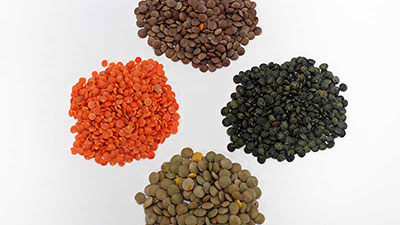
Lentils - green, red, brown, and French.
Texture in Vegetarian Sausages
All grains and legumes contain some protein; however, soybeans produce powders with a protein count of over 90%. Our discussion does not include protein made from milk or whey. Unlike meat proteins, vegetable proteins do not produce "glue" when cut in the presence of salt; however, they can bind water. We could bind a lot of water with gums, but the resulting gel is soft like fruit jelly, and the sausage will be too soft to cut. To produce a firm sausage, use as little water or moist ingredients as possible. Obtaining a good texture is harder to accomplish with veggie sausages because traditionally used binders such as egg white, gelatin, or non-fat dry milk are not used by vegetarian purists. There is, however, a variety of ingredients which, when smartly used will produce a sausage with a good texture. Flaxseed emulsion, described later, is quite sticky and contributes positively to a stronger texture.
The sausage must look and feel like a sausage. When it is cut across, each slice should keep together and hold its own. The casing should peel off easily. Would you buy sliced ham or bologna that would break into many individual pieces?
Once the sausage has been cut, its texture will improve, and the sausage will firm up due to evaporating moisture, even when kept in a refrigerator. The texture can be controlled with:
- Emulsions - soy protein or flaxseed.
- Hydrocolloids - gums made from seaweeds that are used by the food industry. Flours and starches may be considered simple gums.
Most commercially produced vegetarian sausages are of emulsified type, eg. veggie hot dogs. It is much easier to place everything into a food processor and then stuff the resulting paste into a casing. They look like meat hot dogs, unfortunately they don't taste like them. Vegetarian sausages that are not emulsified in a food processor are harder to make. The difficulty lies in controlling texture, it is much harder to produce a vegetarian sausage that contains rice, barley or oats and to bind those materials with spices in such a way that they will not crumble when the sausage is thinly sliced. Unlike traditional homemade meat sausages, the casing is not made of animal intestines but of synthetic ingredients.
When the texture is under control, the sausage can contain an infinite number of materials, some of which may be considered “show” pieces. For example, slices of rehydrated apples or plums, raisins, olives or nuts. Filler materials such as tofu, potatoes, barley, rice, oats, rusk, breadcrumbs, and soaked bread can be used. Potato flakes, potato flour, chickpea flour, semolina, rice flour, starches, and textured vegetable protein (TVP) can be added as well. Most people love bread pudding, and bread pudding sausage can easily be made. There is no shortage of ingredients, and hundreds of recipes can be created.
Binding Ingredients
The main difficulty with making vegetarian sausages is the texture. As they do not contain meat protein or solid fat, new procedures must be introduced to bypass the established ways of making sausages. The following information is of crucial importance as it will enable you to understand how the texture in meat sausages is formed and what can be done to improve the texture of vegetarian sausages.
Meat sausages - the texture of meat sausages is influenced by the amount of meat glue (exudate) produced by meat proteins and the amount of gelatin obtained from collagen, which resides in meat cuts rich in connective tissue. Proteins are released from muscles during cutting or grinding and then dissolve in salt and water, creating a sticky liquid that glues meat particles together. Grind lean meat through a fine plate, add salt, and start mixing or rather kneading the mass for 5 minutes. The mass becomes sticky because meat starts to release proteins, which dissolve in salt and water producing a sticky substance. Sausage makers mix meat with spices until the meat releases the glue and then the sausage is stuffed.
Meat cuts rich in connective tissue (collagen) contribute to the binding of meat particles, in other words to its texture. Sinews, gristles, silver screen, pork cheeks (jowls), feet, skins, generally speaking parts rich in connective tissue are emulsified and become a paste. These parts contain collagen, which, upon heating, becomes a liquid gel that acts like glue. The gel is reversible and, upon cooling, becomes a solid clear gel that holds particles together. Those parts are needed for making traditional head cheese, meat jelly, liver sausages or any quality meat product, however, a commercially produced gelatin which is made from pork skins will produce the same effect. Additionally, collagen is able to bind water which provides more juiciness to the product. There is no need for extra ingredients or chemicals as the meat contains all that is needed to produce a great texture. Fresh meat, salt and pepper are all that is needed.
Fat - any sausage, whether made with meat or not, needs some fat. The fat carries the flavor and provides a pleasant slippery sensation known as "mouthfeel" to our tongue. The undisputed fact remains that man has evolved as a carnivorous creature which can be attributed to many factors:
- A slaughtered animal satisfied the tribe's needs for many days.
- Meat, especially fat, supplies plenty of calories. No vegetables, fruits, or berries can match the calories provided by meat. For people living in cold climates, those calories were needed not just to satisfy hunger but also to maintain body temperature, which requires plenty of fuel. Most cold-climate animals would not survive the winter if they did not accumulate a sufficient amount of fat in the summer.
- In northern areas, the availability of fruits or berries was limited to just a few months of the year, but animals were always around.
- For most of his existence, man did not know how to grow food. The man was a hunter and not a farmer.
By eating meat, fish, birds, and eggs, our palate has grown accustomed to the sensation of fat which is not easy to duplicate. Only in recent years, the latest discoveries have opened a path for making low-fat products that have an acceptable taste and flavor. Anything containing fat provides a satisfying feeling: bacon, mayonnaise, cream cheese, chocolate, ice cream, butter, full milk-the list does not end.
Make coffee with non-fat milk and one with full milk, and you will taste the difference. You cannot make top-quality sauce without butter. We are not advocating choosing a high cholesterol diet, we are simply trying to establish basic facts as they relate to making quality sausages. A hamburger made from very lean meat tastes like a pile of bread crumbs, but the one with 25% fat is defined as juicy.
If you want to save on fat, you have to increase the moisture content, which will make the sausage feel juicer. You can also use commercially prepared fat replacers, for example, a combination of konjac gum, xantham gum and microcrystalline cellulose. When solid fat is heated, it will melt, but when subsequently cooled, it solidifies again. This also greatly contributes to a better texture of meat sausages.
Fat
Insufficient amounts of fat and resulting poor mouthfeel in vegetarian sausages can be corrected by introducing vegetable oil. Oil, like any fat, drastically increases the calorie count. To lower the amount of oil and still preserve a reasonably good mouthfeel, more water must be added; however, the proper steps must be taken to bind this water inside permanently. This produces a stronger sensation of "juiciness" and a better mouthfeel. The extra amount of water can be immobilized by starch or gums, but there is a danger of the sausage becoming too soft. The vegetable oil is liquid at room temperature, it is liquid when heated, and remains liquid when cooled. It does not solidify. If too much is added, the sausage will become soft and oily. So, the application of oil can be a tricky one and to be on the safe side, a little goes a long way.
The best way to apply oil is to hide it inside the emulsion. A good example is mayonnaise which is all oil, yet we do not see it. Mayonnaise is an egg emulsion, all that is needed is the yolk of an egg, oil and a whisk. In the photo below, each emulsion contains 40% oil. The amount of oil could be increased; however, this might make the sausage too soft. More about emulsions.
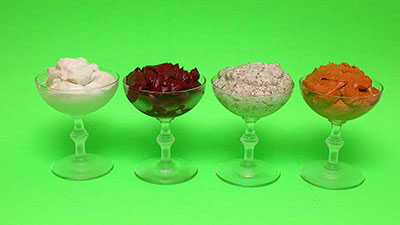
Protein emulsions, from the left: soy, soy with beet juice, flaxseed, soy with annatto.
Advantages of Vegetarian Sausages
The sky is the limit when creating vegetarian sausages:
- Grains, nuts, and beans come in all shapes and colors. Lentil can be green or pink, flaxseed gold or brown, quinoa white or red, cultivated rice is white, wild rice is black, and the list goes on. Potato flour is white, semolina yellow and pea flour green. Vegetarian sausages can be green, white, gray, pink, yellow, red, or even blue, with differently colored showpiece materials embedded into the binding paste of different colors.
- Vegetarian sausages can be sweet. Granola bars, peanut bars, energy bars-all those popular snacks can be made as sausages. A great benefit is that you control how much sugar and calories the sausage will have.
Composition of a Vegetarian Sausage
There is a preconceived perception of how meat sausages should look and taste which is backed by hundreds of years of tradition. One could introduce raisins or cranberries into a liver sausage, grains into a blood sausage, or mix rice and potatoes with ground meat. There are well-known classical meat sausages of this type, however, adding peanut butter, vanilla, honey, raisins and nuts in larger quantities will probably not be accepted because "this is not how the sausage should be made."
To extend their value, sausages were made with additional materials such as barley, buckwheat, rice, oats, dry rolls, or potatoes. Some blood sausages were made with a small amount of blood and grains. We can create a vegetarian sausage by removing the meat component from those sausages. Food products continuously evolve, and sometimes a customer reluctantly accepts new versions of classical dishes.
Take, for example, pizza - originally, it was a thin dough crust with tomato sauce and cheese topping. Then we added pepperoni, sausage, bacon, spinach, broccoli, thicker crust, deep pan pizza, pineapples, and ham toppings - there is no more standard for making pizza. Without a doubt, some old-timers frown upon such practices, but a new generation of creative cooks does not care. The original definition of the sausages has been distorted as well, the best example is McDonalds® Sausage - a meat patty served on a bun. What does a meat patty have to do with a sausage? Following this reasoning further, we may call a hamburger the hamburger sausage as well.
There are no such preconceived notions for vegetarian sausages as there are no established standards. The field of making vegetarian sausages is open to all ideas and suggestions, so let your imagination run loose. Think in terms of sausage evolution. There are pork sausages stuffed with raspberries, which is a logical progression as pork agrees with sweet toppings like apple sauce, cranberries or even mint sauce. We all know that baked ham tastes better spiked with cloves and rubbed with brown sugar. How about honey glazed ham, such combinations were unheard of in the past.
As the definition of the sausage starts fading away, we have an interesting case of vegetarian sausages, as there are no established rules that govern their manufacture. That means that any preconceived notion about making sausages does not apply here. The amount of salt or sodium nitrite, smoking and cooking temperatures are irrelevant, we can unleash our imagination and build them the way we like. Thus the definition of a vegetarian sausage becomes: any food of non-animal origin that is stuffed into a non-animal casing. With so much liberty, why not make snack-type sausages? Chinese are very fond of adding sugar to their sausages, so why not go one step further and create a snack-type of the sausage. Energy bars are expensive vegetarian products - all you have to do is make them round and stuff them into a clear cellulose casing and you create a snack sausage that was custom-designed by you. It is a sure bet that your children would love the idea, ask them for help and you can create a snack that would be both tasty and healthy, unlike commercially sugar loaded products.
A typical vegetarian sausage consists of:
- Principal (dominant) material: grains, legumes, potatoes.
- Protein source: wheat gluten, tofu, textured vegetable protein (TVP).
- Fat: vegetable oil.
- Binder: flour, starch, natural gums, flaxseed emulsion.
- Show material: nuts, seeds, dry fruit, diced tofu, TVP.
- Ingredients: salt, sugar, honey, spices, natural colorings, vegetable stock.
Dominant material names the sausage - pea sausage, potato sausage, rice sausage. Those materials should be easily recognizable when the sausage is sliced, otherwise we end up with a hot dog type emulsified sausage which is a paste stuffed into a casing. TVP or tofu is added to many sausages but will have little bearing on the name of the sausage as it is added as a show material. When we see the name Curry Sausage we already expect that curry will be the dominant spice, the flavor of garlic should be present in Garlic Sausage, and Green Pea Sausage should be of green color. The smoky flavor should be present in Smoked Sausage, White Sausage should be white and Vegetarian Blood Sausage should be reddish, even though no blood has been added.
Commercially produced vegetarian sausages are all of the same type:
Pumpkin Sausages
Vegan sausages can be made from pumpkin or squash. Pumpkin is a filler material with poor binding properties. It contains 91% of water, so a sausage made from 100% pumpkin puree will be very soupy. The slices will not hold their form unless we immobilize this water with flours, starches, or gums. Most gums will easily absorb plenty of water, however, the texture of the sausage will still be too soft, especially when a large proportion of pumpkin is added. In such a case, the pumpkin puree must be thickened so that a sausage will hold its form when thinly sliced. The following is a list of a few common vegetables and the water content they contain:
Pumpkin, raw - water 91%, Squash, raw - water 94%, Potato, raw - water 79%, Sweet Potato, raw - water 77%
Pumpkin may be used as a filler material in sausages; however, due to its high-water content, pumpkin may contribute to a soft texture. Including 50% of pumpkin in a vegan sausage requires a water-hungry thickener such as flour, starch, bread crumbs, rusk, cracker meal, soy protein concentrate, soy protein isolate, non-fat dry milk, gelatin, or gum. We expect a baked pumpkin pie to be soft, but a pumpkin sausage must be much firmer in order to be sliceable. An egg is a wonderful binder and may be used by those who are not strict vegans. Gelatin is a superior water binder, but being of animal origin, it is not included even in vegetarian sausages.
Vegan Pumpkin Sausages
Developing a firm texture in a vegan sausage is difficult as non-meat material tends to create a softer texture. The pumpkin puree must be thickened by adding water-hungry fillers like flour, starch, or soy protein concentrate that will bind free water and thicken the puree. The following combinations produced satisfactory results; in all cases, sausage slices exhibited a firm texture.
Pumpkin puree, 80%, Potato starch, 20%. Texture firm, but gummy.
Pumpkin puree, 80%, Potato starch, 10%, Potato flour, 10%.
Pumpkin puree, 75%, Potato flour, 20%, Guar gum, 5%.
Pumpkin puree, 80%, Coconut flour, 20%.
The above are extreme cases where the ingredients are nothing but pumpkin puree. Usually, pumpkin will be accompanied by other ingredients.
Pumpkin and squash belong to the same family.
Pumpkin sausage can be eaten as it is or sliced and fried.
Potato flour has a potato flavor to it; potato starch has no flavor. Potato starch can thicken a greater amount of liquid than potato flour can.
Potato starch may be replaced with soy protein concentrate (SPI). Guar gum is made from seaweeds and displays neutral flavor.
All of these components are easily available in supermarkets, health stores or online.
Preparing the Pumpkin
Pumpkins are plentiful at Halloween time; however, they require some preparation. Pumpkins are hard, so peeling the skin off is a waste of time. Once the pumpkin is partially cooked, the skin comes off easily.
The flesh of pumpkin contains a lot of connective fiber, and using a potato masher or blender might be a struggle. Place the pumpkin flesh in a food processor and emulsify into the puree. Don’t add any water, as this will create a soupy sausage.
Commercial Pumpkin Puree
There is plenty of inexpensive canned pumpkin puree available in every supermarket. It is ready to be used without further preparation the moment the can is open.
Although making pumpkin puree is a simple, fool-proof process, however, it is time-consuming and costlier than purchasing a canned product.
Spices
The commercial spice mixes include cinnamon, nutmeg, cloves, ginger, and allspice which are easily available. Nothing stops you from making your own spice mix, the advantage is that you can modify it to your own liking, for example, adding a touch of cayenne pepper.
Flours and Starches
All common flours or starches can be used; however, potato starch works at lower temperatures than cornstarch. When thickening gravy or sauce with cornstarch, we need to bring the mixture to a boil, but we can accomplish the same effect with potato starch at a lower temperature. During production, meat sausages are usually cooked at 80° C (176° F), and at this temperature, potato starch works just fine. In a liquid, potato starch reaches its maximum thickening power at 158 - 176° F (70 - 80° C). Cooking meat sausages at boiling temperature (100° C/212° F) will melt fats and will negatively affect the texture of the sausage. Potato flour has a potato flavor to it; potato starch has no discernible flavor. Potato starch can thicken a greater amount of liquid than potato flour.
Almond and Coconut Flour
These two flours can play an important part in the manufacture of vegan sausages because:
- They provide a unique flavor.
- They supply fat (oil).
Coconut flour contains a lot of fiber and is a wonderful binder. Just 1 part of coconut flour binds 3-4 parts of water. It combines very well with pumpkin puree.
Almond flour is less effective as a binder as 1 part of almond flour binds only 1 part of water.
Almond flour is much more expensive than coconut flour.
Naming Vegetarian Sausages
Commercially produced vegetarian sausages are all of the same type: they are emulsified sausages like hot dogs, and their flavor is in desperate need of improvement. All ingredients are dumped into a bowl cutter, which is a huge food processor, and a set of 3-4 knives rotate with an astonishing speed of a few thousand revolutions per minute. At the same time, the bowl containing all materials slowly rotates around. The knives, due to friction, will burn in no time, so to protect them about 30% of crushed ice or cold water is added. Then, this paste is filled into a casing. All those commercially produced veggie sausages include tofu, soy protein, gums and plenty of other ingredients.
A vegetarian sausage does not always need to be of the same diameter, display the same color, have the same emulsified texture, and be made with tofu. Hundreds of grains, flours, and starches come in different shapes, sizes, and colors. There are seeds, dry fruits, and nuts that can be utilized. Flours, starches, and gums will easily bind grains and other components together. The sausage can look visually pleasing, it can have a great particle recognition, meat like chewy texture and great flavor. And it can be stuffed in different diameter casings.
If barley is the main ingredient, the sausage is called Barley Sausage; if potatoes are the main filler, call it Potato Sausage, and so on: Quinoa Sausage, Lentil Sausage, Bean Sausage, Split Pea Sausage etc. Many of those sausages will contain tofu, wheat gluten, or textured vegetable protein (TVP) as show material in addition to the main material. Wheat gluten is probably the closest material that resembles the texture of meat ho;wever, we have tried to limit its use in our recipes as many people are gluten-sensitive.
The recipes were chosen for their academic value and originality, however, follow the quote below and feel free to improvise.
Let us quote Madame Benoit, the famous Canadian cookery expert and author who once said:
"I feel a recipe is only a theme, which an intelligent cook can play each time with a variation."
The quote says it all - improvise and create your own recipes. If you like your creation it must be a good sausage, if you have any doubts, try again.
Vegetarians
If someone refers to themselves as vegetarian, the general assumption is that they are lacto-ovo vegetarian. That means they don't eat animal products that require the killing of an animal, but eggs and dairy are fine. Rennet and gelatin are options they may or may not include. Some vegetarians will just simply not eat red meat but will eat fish and poultry. A person who eats fish and/or poultry is by no means a vegetarian, just a selective omnivore. Gelatin comes from a dead animal, it is derived from pork skins, pork, horses, cattle bones, or split cattle hides so it is not a vegetarian ingredient.
Vegans
Vegans, in the strictest sense, will not eat any animal flesh, nor will they eat animal-derived products. In the purest sense, a strict vegan will exclude dairy and honey, as the latter may include a piece of a bee's leg or wing.

